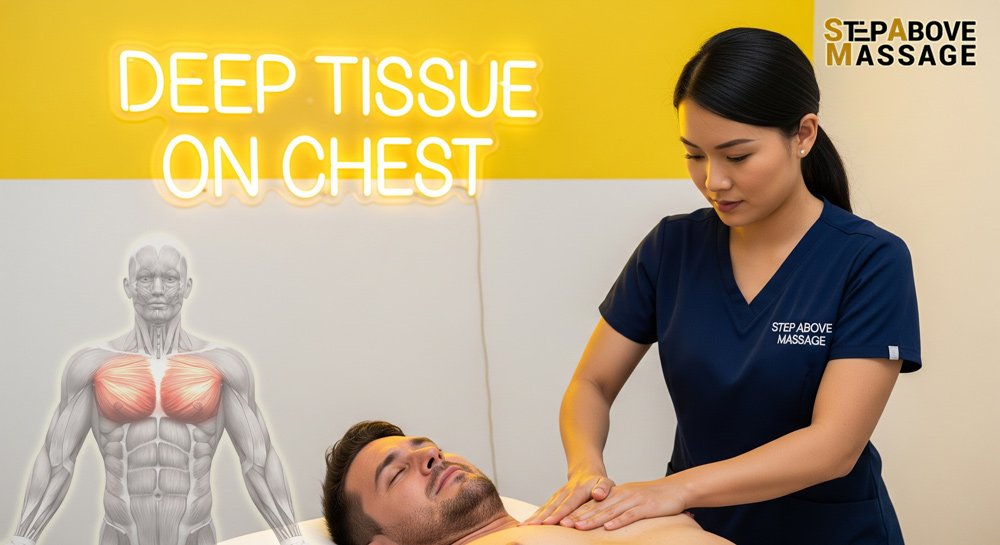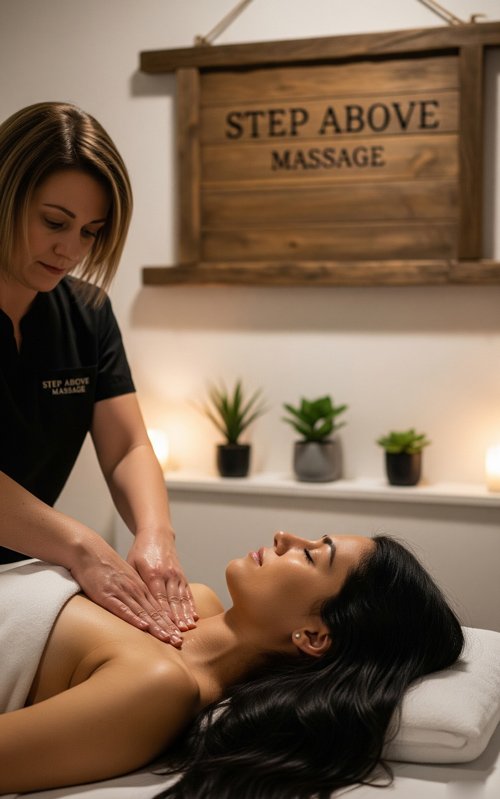📍 Important Update
Only our Raleigh office (804 Salem Woods Drive) has availability on Saturday, September 20th.
✨ This location is just 6 miles away from our Wake Forest office!

Table of Contents
ToggleMassaging the chest and abdomen offers a powerful way to release tension, improve posture, and support vital functions like breathing and digestion. A professional chest massage targets key muscle groups that become tight from sedentary habits, stress, or physical strain. Understanding the full range of chest massage benefits can empower you to seek this therapy, which is ideal for office workers, athletes, or those recovering from surgery. The practice involves various chest massages designed to restore balance and function, delivering a therapeutic chest message of relief to tense tissues.
The chest houses the pectoralis major and minor, large muscles that stretch from the sternum and clavicle to the upper arm and scapula. These muscles often tighten from hunching over desks or phones, leading to rounded shoulders, restricted breathing, or neck pain. A targeted pectoral muscle massage can relieve this chronic tension and restore proper alignment. Proper massage for pectoral muscles is essential for anyone looking to improve their upper body posture and mobility.
The abdomen contains the rectus abdominis, obliques, and transversus abdominis, which form your core. These muscles can become tense from poor posture, emotional stress, or digestive issues, limiting movement and affecting gut health. Abdominal therapy works to loosen these restrictions, improving both flexibility and digestive function.

When the chest is tight, breathing becomes shallow and inefficient. A chest congestion massage is specifically designed to increase the flexibility of the ribcage and improve lung capacity. Similarly, a gentle chest massage for cough can help loosen mucus and ease respiratory discomfort. In the abdomen, clockwise kneading stimulates the muscles around the digestive tract, encouraging regularity and easing bloating.
The chest is often where the body holds tension related to anxiety and stress, leading to that “tight chest” sensation. A chest hot massage, which uses warmed oils or compresses, can be profoundly relaxing. This warmth helps release stored tension, promotes deeper breathing, and fosters a sense of calm. The abdomen is also closely tied to our emotions; abdominal therapy can soothe stress-related digestive issues and support emotional balance.
Easing muscular pain is a primary goal of this therapy. A focused chest muscle massage can reduce discomfort in the pectoralis major and minor caused by prolonged sitting or physical exertion. For deeper, more persistent tension, a deep tissue chest massage can break down adhesions and scar tissue, enhancing tissue elasticity and improving range of motion. This process also boosts blood flow, delivering vital oxygen and nutrients while clearing metabolic waste, which speeds up recovery.
A professional session begins with creating a comfortable environment. Your therapist will have you lie on a padded table, often with a bolster under your knees to reduce lower back strain. They will communicate with you to understand your pain points and medical history, ensuring the session is tailored and safe. Warmed oil is often used to prepare the muscles with long, gliding strokes.
The technique for an effective pectoral massage involves working along the muscle fibers. A therapist may use flattened fingers or the heel of their hand to apply pressure, starting from the sternum and moving outward toward the upper arm. Learning how to massage pectoral muscles this way ensures comprehensive release. This foundational approach is key to any professional massage pectoral muscles session. The therapist will also address the deeper pectoralis minor, using precise strokes to avoid nerve entrapment. A skilled practitioner knows the best chest massage combines broad strokes with detailed trigger point work.
For a more intensive experience, some therapists offer unique modalities. One powerful technique is ashiatsu chest therapy, where the practitioner uses their feet to deliver deep, controlled pressure across the pectoral muscles. This form of body massage chest can be incredibly effective for releasing stubborn tension. A comprehensive chest body massage integrates this focused work with therapy for the back, neck, and shoulders for holistic relief.
A professional chest massage for women requires a deep understanding of anatomy and a commitment to client comfort and safety. Draping is meticulously managed, and communication is paramount. The techniques used during a female chest massage are adapted to be both effective and respectful. A therapist skilled in pectoral massage for women will know how to address tension without causing discomfort. This approach applies whether it’s a therapeutic session or a general massage focusing on postural correction.
Therapy must also be adapted for different client needs. For instance, a chest massage man session might require different pressure or techniques to work through denser muscle tissue. A proper chest hair massage involves using sufficient oil or lotion to ensure that strokes are smooth and comfortable, preventing any pulling or irritation.
Many people ask, “how do you massage your chest?” Learning how to do chest massage at home can be a great way to manage tension between professional sessions. To begin massaging chest tissues, start with warmed oil and use gentle, gliding strokes across your pectoral muscles, moving from the center of your chest outward. Use your fingertips to apply light pressure in circular motions. When you learn how to chest massage yourself, the key is to listen to your body and avoid excessive force. You can also use a foam roller or massage ball to learn how to massage chest muscles in hard-to-reach areas.
For targeted relief, you can adapt your self-massage. A gentle chest massage for chest pain related to muscle strain can be beneficial, but it’s crucial to consult a doctor first to rule out serious conditions. Learning how to massage chest pain safely involves using light pressure and stopping immediately if you feel any sharp or radiating pain.
Modern research supports the benefits of this work. Clinical trials have shown that targeted therapy provides superior pain relief for chronic muscle tightness. Case studies also confirm its benefits for conditions like fibromyalgia, supporting the value of both a professional pec massage and regular self-care.
This therapy is not suitable for everyone. Individuals with blood clotting disorders, recent surgeries in the area, or fragile bones should consult a doctor. Pregnant individuals also require specialized techniques and medical approval. Always communicate any health concerns to your therapist.
To ensure a safe and effective experience, it is essential to choose a licensed professional. You can start by searching online for ” chest massage near me ” and then checking the credentials and reviews for local therapists. A qualified practitioner will be skilled in a variety of techniques and will prioritize your comfort and well-being.
From a professional deep tissue chest massage to a simple self-care routine at home, the practice of massaging chest muscles offers profound benefits. We’ve covered how to massage pectoral muscles, the benefits of a chest congestion massage, and the specifics of a female chest massage. By understanding these techniques, you can actively improve your posture, breathing, and overall well-being.
Ready to experience the benefits of a professional chest and abdominal massage? The licensed therapists at Step Above Massage specialize in the targeted, therapeutic techniques discussed in this guide. Serving clients in both Raleigh and Wake Forest, we are dedicated to helping you relieve chronic pain and improve your well-being. Book your personalized session today and feel the difference expert care can make.
While not a direct treatment for heart conditions, chest massage offers indirect benefits. By reducing stress and releasing tension in respiratory muscles (pectorals), it can promote relaxation and improve circulation, which are positive for overall cardiovascular wellness. Always consult your doctor for any heart-related health concerns.
Yes, for a licensed therapist, massaging the pectoral (chest) muscles is a normal and highly beneficial part of therapeutic massage, especially for correcting posture and relieving tension from daily activities like driving or using a computer. A professional will always communicate clearly and ensure you are comfortable.
Absolutely. Your privacy and comfort are paramount. Therapists use meticulous draping techniques. For female clients, all sensitive breast tissue remains completely covered, and only the specific muscles being worked on (like the upper pectorals near the shoulder) are accessed.
📍 Important Update
Only our Raleigh office (804 Salem Woods Drive) has availability on Saturday, September 20th.
✨ This location is just 6 miles away from our Wake Forest office!